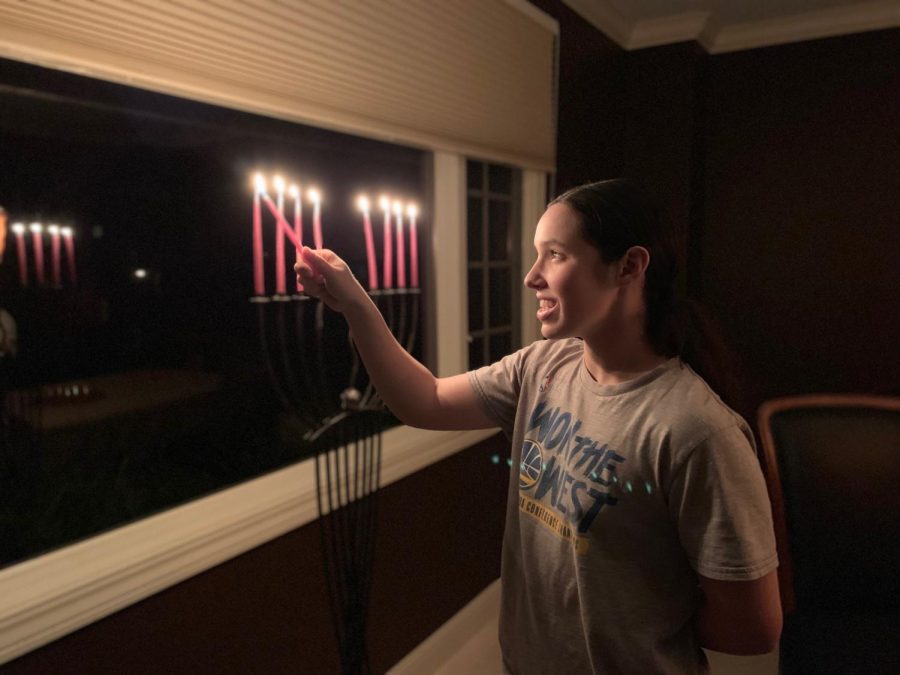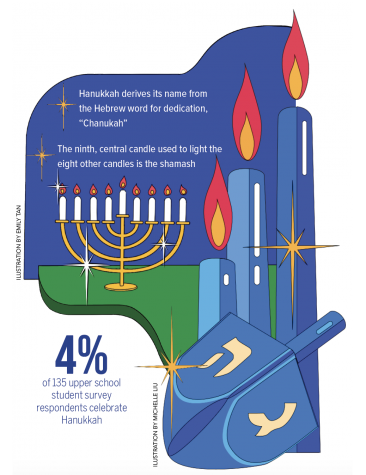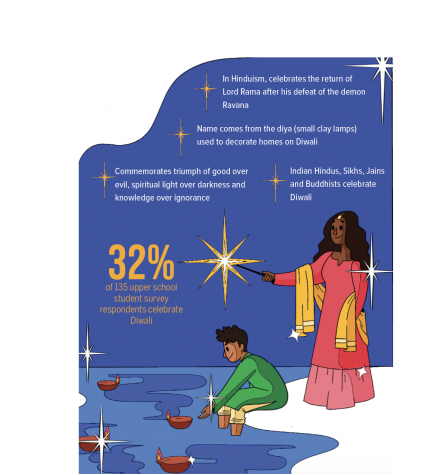Holidays at Harker
Upper school community shares festive traditions, memories and hopes this holiday
As the days turn colder and nights grow longer, the festive holidays of Hanukkah, Christmas and Diwali bring light to the Harker community. Despite limitations this year caused by the newest stay-at-home order in Santa Clara County, families have found ways to still preserve the holiday spirit this season.
Hanukkah
The Jewish holiday Hanukkah, which receives its name from the Hebrew word for dedication, “Chanukah,” commemorates the rededication of the Second Temple of Jerusalem.
Each night, a new candle is lit on the menorah, a lamp with nine branches of candles. The ninth candle, or the shamash, is used to light the other eight to celebrate the eight days for which the original menorah miraculously burned with only enough oil for one day’s lighting.
The celebration of Hanukkah centers around the menorah, a symbol that brings light and joy into the home. The candles of the menorah are lit from right to left, with the shamash burning brightly in the center each night.
“My favorite part of Hanukkah is the eighth night when all the [candles] are lit,” upper school psychology teacher Dr. Julie Turchin said. “I don’t think it’s a coincidence that right near the winter solstice when it’s dark out, we have all these celebrations that involve light.”
Families also celebrate Hanukkah by giving gifts to each other, playing games like dreidel and cooking traditional fried foods, such as latkes (potato pancakes) and sufganiyah (jelly-filled donuts).
“I’m a big foodie, so probably the eating [is my personal favorite part of Hanukkah],” Joshua Tseitlin (11) said. “It’s also nice because [I can meet] a lot of [relatives] that don’t show up normally.”
For freshman Zachary Blue and senior Ellis Goldman, the tradition of lighting the menorah each night is important to them, because they are able to spend that special time of celebration and reflection with family for eight days each year.
“Each night we’re lighting a new candle, and our thankfulness goes into each of those candles,” Zachary said. “So I really think that giving thanks and spending time with family is the most important part [of Hanukkah].”
Ellis echoed this idea.
“In comparison to a lot of the Jewish holidays, [Hanukkah is] definitely more family-oriented. They all are in a sense, but in comparison to Christmas, it’s the closest you get [to] the holiday season vibes,” she said. “I feel like [the traditions are] a lot more special and meaningful in comparison to other [holidays].”
Christmas
Christmas is celebrated to commemorate the birth of Jesus Christ, traditionally observed on Dec. 25. The holiday is closely tied to the legend of Santa Claus and often associated with evergreen trees, candy canes, pointsettias and presents.
Practicing Christians observe the holiday with Midnight Mass, a special celebration that begins on Christmas Eve. To account for the county’s social distancing protocols this year, new alternatives to in-person religious gatherings have emerged, such as outdoor church services, video livestreams and Zoom calls. Still, the magic of Christmas lives on for many.
“It’s a really happy time, celebrating the birth of Jesus,” upper school math teacher Dr. Bune Bloomquist said. “I really like Christmas mass, and then all of the Christmas carols. I love music.”
Christmas traditions can also include decorating the house with festive lights and garlands. Families often set up a Christmas tree together as well, usually trimmed with ornaments, tinsel and a star. This particular tradition emerged from the 16th century, when Christians first brought evergreen trees into their homes and decorated them with lighted candles.
“We put up the decorations a weekend earlier than we normally do,” Emma Andrews (12) said. “It’s a very nice atmosphere in my house at this time of year, and it definitely helps with everything crazy going on.”
For other families, Christmas represents a time of relaxation dedicated to bonding with loved ones, may it be by watching festive movies, ice skating, going on road trips or more.
“It’s not like we have a dedicated [Christmas tradition]; it’s more relaxed,” Max Xing (9) said. “I’m still sad we can’t go skiing this year and stay at a cabin in the woods for four days, but I’ll take it.”
Even without being able to celebrate in the same ways as in previous years, members of the Harker community embrace the opportunity to appreciate friends and family during the Christmas season.
“I’m pretty happy to be able to spend time with just my parents and my sister,” Alex Zhai (12) said. “It’ll definitely be different, but Christmas is really just about spending time with family so we’ll still be doing that, even if there are no fancy trips or anything.”
Diwali
Also known as the “Festival of Lights,” Diwali originated as a Hindu celebration that commemorates the triumph of good over evil, spiritual light over darkness and knowledge over ignorance with an emphasis on connecting with family. Diwali derives its name from the Sanskrit word “dipavali,” meaning “row of lights,” referring to the rows of diya, or clay candles, that followers use to represent the essence of Diwali.
The date of its observance usually falls in October or November, varying based on the Hindu lunar calendar. Observers celebrate Diwali over the course of five days, with a specific focus on each day.
The first day, Dhanteras, consists of charitable giving, service and cleaning, and devotees will often make rangoli, or flowers drawn from colored powders. The next day, Hindus will place diyas around their home, and for the main day of Diwali, Indians dress in new clothing, perform puja, or worship, at temples and light firecrackers.
“You get to meet a lot of people [whom] you don’t necessarily get to meet on an everyday basis,” Aria Jain (10) said. “I also really like wearing traditional clothes because usually I don’t wear it on other occasions.”
Another major activity that Indians partake in on the main day of Diwali is lighting diyas and setting off fireworks.
“I think [Diwali is] special because of what we do to celebrate,” Arnav said. “The sparklers and the lights look really nice against the dark sky.”
Observers primarily enjoy sweets on Diwali, such as halwa, a thick mix of grated vegetable and condensed milk, and laddu, sugary balls of flour often flavored with nuts. In addition to the traditions of making rangoli and lighting diya, many families also gather to tell the history and stories of Diwali, a highlight for attendance coordinator Ritu Raj.
“My personal favorite part [is] bringing family together, understanding the importance of our rituals, the stories behind it and passing that along to my daughters,” Raj said.
Through an understanding of Diwali’s history and meaning, Hindus have the opportunity to immerse themselves in their culture.
“I just find it kind of cool how I can still celebrate something that’s part of my culture,” Kushal Shah (12) said. “Even though I’ve never actually lived in India, I feel like it’s just a part that I can connect back to my roots.”

Emily Tan (12) is the co-editor-in-chief of The Winged Post. This is her fourth year on staff, previously serving as the Winged Post features editor, and...

Michelle Liu (12) is the co-editor-in-chief of The Winged Post. She joined the journalism program in her sophomore year as a reporter and became the Winged...


















![“[Building nerf blasters] became this outlet of creativity for me that hasn't been matched by anything else. The process [of] making a build complete to your desire is such a painstakingly difficult process, but I've had to learn from [the skills needed from] soldering to proper painting. There's so many different options for everything, if you think about it, it exists. The best part is [that] if it doesn't exist, you can build it yourself," Ishaan Parate said.](https://harkeraquila.com/wp-content/uploads/2022/08/DSC_8149-900x604.jpg)




![“When I came into high school, I was ready to be a follower. But DECA was a game changer for me. It helped me overcome my fear of public speaking, and it's played such a major role in who I've become today. To be able to successfully lead a chapter of 150 students, an officer team and be one of the upperclassmen I once really admired is something I'm [really] proud of,” Anvitha Tummala ('21) said.](https://harkeraquila.com/wp-content/uploads/2021/07/Screen-Shot-2021-07-25-at-9.50.05-AM-900x594.png)







![“I think getting up in the morning and having a sense of purpose [is exciting]. I think without a certain amount of drive, life is kind of obsolete and mundane, and I think having that every single day is what makes each day unique and kind of makes life exciting,” Neymika Jain (12) said.](https://harkeraquila.com/wp-content/uploads/2017/06/Screen-Shot-2017-06-03-at-4.54.16-PM.png)








![“My slogan is ‘slow feet, don’t eat, and I’m hungry.’ You need to run fast to get where you are–you aren't going to get those championships if you aren't fast,” Angel Cervantes (12) said. “I want to do well in school on my tests and in track and win championships for my team. I live by that, [and] I can do that anywhere: in the classroom or on the field.”](https://harkeraquila.com/wp-content/uploads/2018/06/DSC5146-900x601.jpg)
![“[Volleyball has] taught me how to fall correctly, and another thing it taught is that you don’t have to be the best at something to be good at it. If you just hit the ball in a smart way, then it still scores points and you’re good at it. You could be a background player and still make a much bigger impact on the team than you would think,” Anya Gert (’20) said.](https://harkeraquila.com/wp-content/uploads/2020/06/AnnaGert_JinTuan_HoHPhotoEdited-600x900.jpeg)

![“I'm not nearly there yet, but [my confidence has] definitely been getting better since I was pretty shy and timid coming into Harker my freshman year. I know that there's a lot of people that are really confident in what they do, and I really admire them. Everyone's so driven and that has really pushed me to kind of try to find my own place in high school and be more confident,” Alyssa Huang (’20) said.](https://harkeraquila.com/wp-content/uploads/2020/06/AlyssaHuang_EmilyChen_HoHPhoto-900x749.jpeg)






